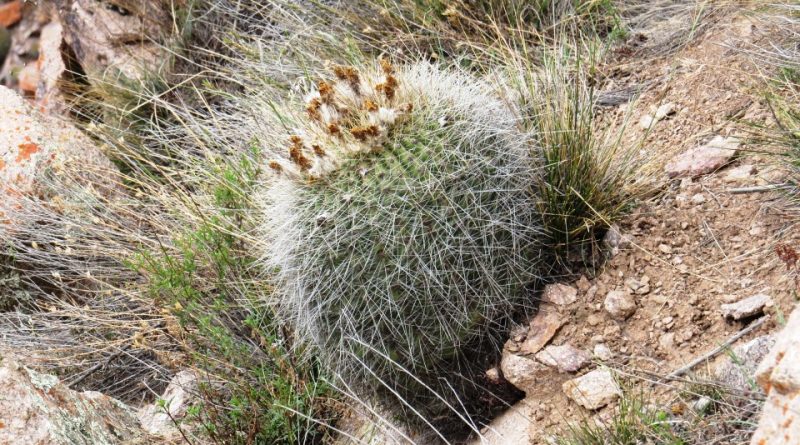Soehrensia formosa
Soehrensia formosa
The koko (Soehrensia formosa (Pfeiff.) Backeb. 1959) is a succulent species belonging to the Cactaceae family.
Systematic –
From a systematic point of view it belongs to:
Eukaryota domain,
Kingdom Plantae,
Division Magnoliophyta,
Class Magnoliopsida,
Order Caryophyllales,
Cactaceae family,
Subfamily Cactoideae
Tribe Cereeae
Subtribe Trichocereinae
Genus Soehrensia,
Species S. formosa.
The terms are synonymous:
– Acanthocalycium formosum (Pfeiff.) Backeb. (1936);
– Echinocactus formosus Pfeiff. (1837);
– Echinopsis formosa (Pfeiff.) Jacobi ex Salm-Dyck. (1850);
– Lobivia formosa (Pfeiff.) Dodds. (1937);
– Trichocereus formosus (Pfeiff.) F.Ritter. (1980);
– Trichocereus randallii Cárdenas (1963).
The following subspecies are recognized within this species:
– Soehrensia formosa subsp. formosa;
– Soehrensia formosa subsp. kieslingii (Rausch) Schlumpb.;
– Soehrensia formosa subsp. korethroides (Werderm.) Schlumpb.;
– Soehrensia formosa subsp. randallii (Cárdenas) Schlumpb.;
– Soehrensia formosa subsp. rosarioana (Rausch) Schlumpb..
Etymology –
The term Soehrensia is in honor of Johannes Soehrens (?-1934), Dutch botanist, professor and director of the Botanical Garden of Santiago de Chile, who specialized in the study of cacti.
The specific epithet formosa comes from the Latin “formósus, a, um”, that is, of beautiful shapes, beautiful.
Geographic Distribution and Habitat –
Soehrensia formosa is a plant native to South America. In north-western Argentina, Bolivia and northern Chile, in particular it is widespread in the Bolivian department of Tarija, in the Argentine provinces of Salta, Tucumán, Catamarca, La Rioja, San Juan and Mendoza as well as in the adjacent north-east of Chile.
Its habitat is that of the valleys and along the rocky slopes of the Andean cordillera up to around 4,000 m above sea level.
Description –
Soehrensia formosa is a succulent plant that initially grows isolated, then occasionally branches from the base and can form groups.
The stem is spherical to cylindrical in shape, light green to blue-green in color with shoots reaching up to 1.5 meters in diameter and 25 to 50 centimeters in height. It has 27-50 rounded ribs present, clearly tuberculate, in which the dark areolas are located up to 1 cm apart from each other. Yellowish to reddish-brown acicular spines emerge from them. The central spines 8 to 58 are 3 to 20 cm long. Radial spines 9 to 15 are broad, straight or slightly curved, and up to 3 centimeters long.
The flowers are large, funnel-shaped, red to orange-red or yellow in color, 6-9 cm long and have exactly that diameter.
The fruits are spherical, green in color with a length of up to 3 centimeters and 4 centimeters in diameter.
Cultivation –
Soehrensia formosa is a slow-growing succulent plant that grows or should be cultivated in full sun, or in any case at the maximum possible brightness.
From a pedological point of view, it prefers particularly draining soils in very poor and rocky areas.
For cultivation, substrates must be chosen consisting of approximately 50% of common fertilized garden soil and the remaining part, in equal measure, of coarse silica sand and crushed stone.
It has a high resistance to dry cold, being able to resist for a short period down to -10°C, but not to humid cold which can cause rot, even if it is more resistant, from this point of view, than other cacti. Its ideal location outdoors, where the climate allows it, is in “desert” gardens together with other xerophytes, elsewhere it should be grown in pots with the same methods indicated above.
Therefore in climates characterized by humid winters it must be sheltered and kept dry at temperatures possibly between 0 and 5°C, this cold and dry rest period is useful for stimulating flowering; in summer it should be watered regularly, but allowing the soil to dry completely before watering again.
Please note that this plant is one of the species listed in Appendix II of Cites (a species for which trade is regulated at an international level).
Customs and Traditions –
Soehrensia formosa is a plant that was first described as Echinocactus formosus by Ludwig Georg Karl Pfeiffe was published in 1837.
Boris O. Schlumpberger subsequently placed the species in the genus Soehrensia in 2012.
This plant is known by the common names of: “koko”, “pasakana” (Spanish).
It is a plant that has almost exclusively ornamental uses, suitable for rock gardens and, in any case, as well as in pots, it can be cultivated in areas with little need for irrigation and in poor but well-drained soil.
This plant can be cultivated in sunny areas but is still resistant, even if for short periods, down to -10 °C.
Preparation Mode –
Soehrensia formosa is a plant used and cultivated almost exclusively for ornamental purposes.
Guido Bissanti
Sources
– Acta Plantarum – Flora of the Italian Regions.
– Wikipedia, the free encyclopedia.
– GBIF, the Global Biodiversity Information Facility.
– Useful Tropical Plants Database.
– Conti F., Abbate G., Alessandrini A., Blasi C. (ed.), 2005. An annotated checklist of the Italian vascular flora, Palombi Editore.
– Pignatti S., 1982. Flora d’Italia, Edagricole, Bologna.
– Treben M., 2000. Health from the Lord’s Pharmacy, Advice and experiences with medicinal herbs, Ennsthaler Editore.
Photo source:
– https://inaturalist-open-data.s3.amazonaws.com/photos/106909121/original.jpeg
– https://mediaphoto.mnhn.fr/media/1441381931381tpJ0MKPyi1ewuwnY
Attention: Pharmaceutical applications and food uses are indicated for informational purposes only, they do not represent in any way a medical prescription; we therefore decline any responsibility for their use for healing, aesthetic or food purposes.


